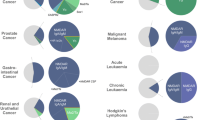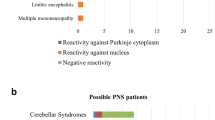Abstract
The presence of circulating antineuronal antibodies has been associated with paraneoplastic neurological syndromes (PNS). Ri antibodies are often associated with lung or breast cancer, but the prevalence of such antibodies in large cancer materials is largely unknown. We used a highly sensitive immunoprecipitation assay to study the level of Ri antibodies in blood samples from 200 patients with small cell lung cancer (SCLC), 253 patients with breast cancer and 557 patients with ovarian cancer. Two hundred blood donors and six Ri positive PNS patients served as controls. The recombinant antigen used in the immunoprecipitation assay was radiolabeled by a coupled in vitro transcription and translation (ITT) technique, enabling low levels of antibodies to be detected. None of the blood donors contained Ri antibodies, whereas all of the sera from the PNS patients were positive. Ri antibodies were present in 4.5% of the patients with SCLC, 0.8% of the patients with breast cancer and in 0.2% of the patients with ovarian cancer. Retesting of the Ri positive samples with immunofluorescense and immune blot showed that the immunoprecipitation technique was more sensitive than the other immune assays. Ri antibodies were not associated with PNS in the patients with breast or ovarian cancer. Neurological data were not available for the SCLC patients, but in these, Ri antibodies were not associated with survival.


Similar content being viewed by others
References
Darnell RB, Posner JB (2003) Paraneoplastic syndromes involving the nervous system. N Engl J Med 349:1543–1554
Vincent A (1999) Antibodies to ion channels in paraneoplastic disorders. Brain Pathol 9:285–291
Scaravilli F, Shu FA, Groves M., Thom M (1999) The neuropathology of paraneoplastic syndromes. Brain Pathol 9:251–260
Musunuru K, Darnell RB (2001) Paraneoplastic neurologic disease antigens: RNA-binding proteins and signaling proteins in neuronal degeneration. Annu Rev Neurosci 24:239–262
Pittock SJ, Lucchinetti CF, Lennon VA (2003) Anti-neuronal nuclear autoantibody type 2: paraneoplastic accompaniments. Ann Neurol 53:580–587
Drlicek M, Bianchi G, Bogliun G, Casati B, Grisold W, Kolig C, Liszka- Setinek U, Marzorati L, Wondrusch E, Cavaletti G (1997) Antibodies of the anti-Yo and anti-Ri type in the absence of paraneoplastic neurological syndromes: a long-term survey of ovarian cancer patients. J Neurol 244:85–89
Jongen JL, Moll WJ, Sillevis Smitt PA, Vecht CJ, Tijssen CC (1998) Anti-Ri positive opsoclonus-myoclonus-araxia in ovarian duct cancer. J Neurol 245:691–692
Kikuchi H, Yamada T, Okayama A, Hara H, Taniwaki T, Shigeto H, Sasaki M, Iwaki T, Kira J (2000) Anti-Ri-associated paraneoplastic cerebellar degeneration without opsoclonus in a patient with a neuroendocrine carcinoma of the stomach. Fukuoka Igaku Zasshi 91:104–109
Storstein A, Monstad SE, Nakkestad HL, Husebye ES, Vedeler CA (2004) Paraneoplastic antibodies against HuD detected by a sensitive radiobinding assay. J Neurol 251:197–203
Monstad SE, Drivsholm L, Storstein A, Aarseth JH, Haugen M, Lang B, Vincent A, Vedeler CA (2004) Hu and voltage-gated calcium channel (VGCC) antibodies related to the prognosis of small-cell lung cancer. J Clin Oncol 22:795–800
Rojas-Marcos I, Rousseau A, Keime-Guibert F, Rene R, Cartalat-Carel S, Delattre JY, Graus F (2003) Spectrum of paraneoplastic neurolgical disorders in women with breast and gynecologic cancer. Medicine 82:216–223
Pittock SJ, Kryzer TJ, Lennon VA (2004) Paraneoplastic antibodies coexist and predict cancer, not neurological syndrome. Ann Neurol 56:715–719
Darnell JC, Albert ML, Darnell RB (2000) Cdr2, a target antigen of naturally occuring human tumor immunity, is widely expressed in gynecological tumors. Cancer Res 60:2136–2139
Dalmau J, Furneaux HM, Cordon-Cardo C, Posner JB (1992) The expression of the Hu (paraneoplastic encephalomyelitis/sensory neuronopathy) antigen in human normal and tumor tissues. Am J Pathol 141:881–886
Buckanovich RJ, Yang YYL, Darnell RB (1996) The onconeural antigen Nova-1 is a neuron-specific RNA-binding protein, the activity of which is inhibited by paraneoplastic antibodies. J Neurosci 16:1114–1122
Acknowledgements
We thank Mette Haugen, Kibret Mazengia and Cecilie Totland for technical help. This study was supported by grants from the University of Bergen and Helse Vest.
Author information
Authors and Affiliations
Corresponding author
Rights and permissions
About this article
Cite this article
Knudsen, A., Monstad, S.E., Dørum, A. et al. Ri antibodies in patients with breast, ovarian or small cell lung cancer determined by a sensitive immunoprecipitation technique. Cancer Immunol Immunother 55, 1280–1284 (2006). https://doi.org/10.1007/s00262-006-0121-2
Received:
Accepted:
Published:
Issue Date:
DOI: https://doi.org/10.1007/s00262-006-0121-2




